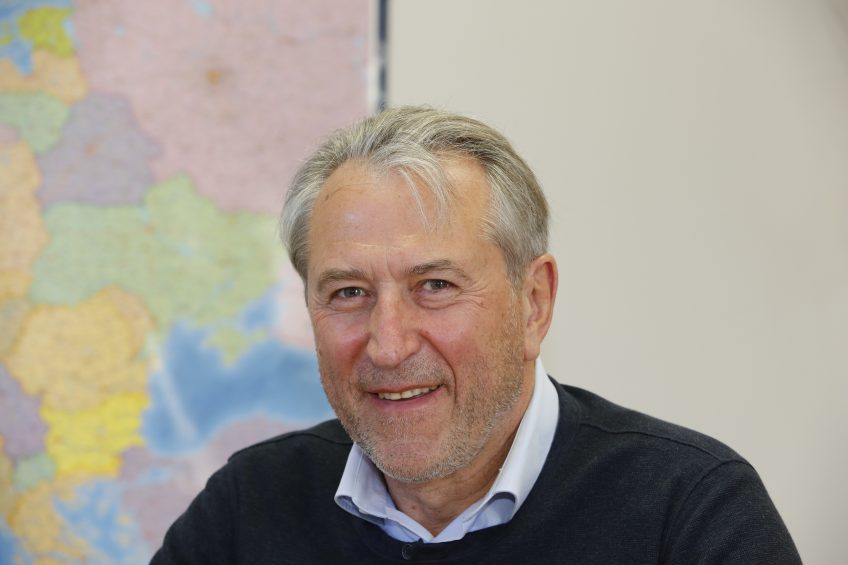Lithuanian pork producer Vyturys grows in difficult market

The Vyturys conglomerate is one of Lithuania’s largest pork producers and has been working hard to reach Western European levels with regard to production and quality. Vyturys is succeeding, as Pig Progress found out.
Vyturys, as one of Lithuania’s largest pork producers, delivers annually over 110,000 finisher pigs – over 10% of Lithuania’s pork production. In addition, it also delivers about 8,000 gilts (JSR). There is also a poultry division with 680,000 layer hens, including a breeding section on a different location. The company also owns a compound feed factory with a 120,000 tonne capacity per year.
Valdemaras Sadaunykas, director and owner, is optimistic about the future. He says, “In 2015, we invested €3 million in renewal of the grower facilities and we had our liquid feeding equipment replaced. We are about to invest in fermentation for just-weaned piglets and we’ll also expand the capacity with another 3,000 sows.”
Pig Progress: Since 2005, Lithuania’s pig industry has shrunk from 3 million to 1 million per year. How come you are still optimistic?
Valdemaras Sadaunykas: “The industry was heavily oriented to Russia. That attractive market lost its appeal because of ever-increasing import taxes, after Lithuania had joined the European Union (EU). Following outbreaks of African Swine Fever (ASF) in Lithuania (as from 2014, ed.), that market even completely disappeared.
“We are now dealing with exactly the same pig prices as the Dutch, the Germans and the Danes. For 10 years, we have been investing to reach a Western European production and quality level. The results tell it all, annually, we have a profit of €2-€3 million.”
Which are pros and cons of Lithuania’s pig business?
“Annually, Lithuania exports about 3.5 million tonnes of grains and that export is growing. Manure deposition, however, is not as easy as one would expect on the basis of our huge arable farming potential. We aim to get rid of our manure against no extra costs.
“Labour is still relatively expensive, but that is not a factor I continue to count on for the future. Half a million of Lithuanians have already left the country. One simply has to pay for motivated employees who also know how to operate modern technology. If only we had a Rabobank! Financing through banks is relatively difficult, only if the authorities cover for you, it’s possible to finance against an interest below 5%. Per annum, we currently pay just over 4% of interest and we are financed for about 70%.”
At which production levels are you these days?
“We wean about 28 piglets per sow per year. Immediately after weaning at 21 days, on average at 6.7 kg, piglets are transferred to our finishing section at a separate location. After 6 weeks on flatdecks, they are transferred to a grower phase for about 7 weeks. After another 7 weeks, at an average weight of 115 kg, they go to the slaughterhouse. Pig mortality on the flatdecks is about 1.5%, during the grower phase 0.8% and during finishing 1.4%. On average, we achieve 745 g/growth/day between 6.5 to 115 kg, at a feed conversion rate of 2.25. We feed cheese whey as well as additional nutrition through liquid feed installations by Weda.”
You stated you would like to expand with another 3,000 sows. Will that be in the form of a new farm or will you expand at the current site?
“We’d like to start a new site to spread our risks – that is mainly due to ASF which has been going round here for 3 years now. Getting all the permits is a slow process; it takes at least 2 years. Even being located miles away from built-up areas will create resistance in society against pig production. Predominantly the odour is used as a reason for protest.”
What happens when African Swine Fever hits a commercial farm? At the Lithuanian farm Rupinskai, they can tell from experience.
You mention African Swine Fever. How to tackle that?
“First, the wild boars that come into the country from Belarus. At the border, Lithuania is placing fences. In addition, Lithuanian game keepers are actively hunting the wild boars to reduce the size of the population.
“In addition, especially backyard farms still do swill feeding. There are about 10,000 farms that altogether have a capacity of 27,000 pigs. What we need are regulations to buy them out; we are currently working on that.”
Is that something to be arranged by those who will stay in business?
“That would be the quickest solution, as we all have the same interest: reform of the backyard pig farms. If you, however, put 10 pig farmers in a room, what you’ll hear is 11 opinions. That is why the Lithuanian government should take its responsibility, possibly financed by a levy on every pig sent for slaughter.”











